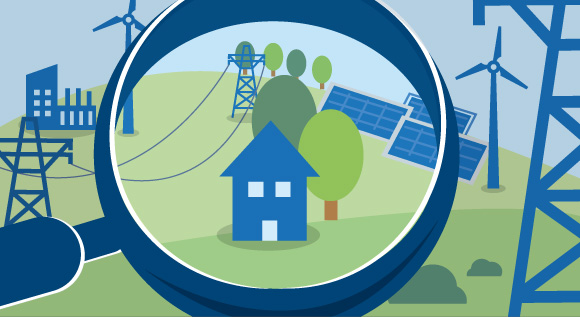What is an ‘efficiency house’?
If you’re interested in building or buying a house, chances are you will have come across the term ‘efficiency house’. But what exactly are they? And how can ‘efficiency houses’ help private households save energy and cash?
 © BMWi
© BMWiEfficiency houses are about saving energy in your private home
Those areas where we use the most energy are also the ones where there is a lot of potential for energy savings. Private homes are no exception. Buildings account for almost 40 per cent of Germany’s final energy consumption. Most of this energy is used for heating and hot water. The German government wants to unlock the potential that lies dormant in the building stock and improve buildings’ energy performance. It has set out an ambitious target of making buildings in Germany close to climate-neutral by 2050, meaning there should be virtually no carbon emissions from buildings anymore. At the same time, primary energy demand, i.e. demand for fossil fuels such as oil and gas, is to be curbed by approx. 80 per cent.
This means that energy efficiency is a key aspect for homeowners and future homeowners to consider. Making sure your home has a strong energy performance is good for the climate – and it can save you cash. What’s even better, if you’re building an energy-efficient house from scratch or improving your home’s energy performance, you’ll be eligible for some attractive funding. One of the things to look out for is the ‘KfW Efficiency House’ standard.
Greater energy efficiency – more cash
Germany’s Reconstruction Loan Corporation (KfW) provides financial support for homeowners who are having their home modernised to make it more energy-efficient, and for buyers who are investing in an energy-efficient home. A ‘KfW Efficiency House’ is a house that meets a certain category of standards used by KfW to classify a building’s energy needs. The amount of funding you will get from KfW will partly depend on what standard of efficiency house you have opted for.
The ‘KfW Efficiency House’ standard is based on two parameters: the annual energy needs of the building and the amount of heat that is allowed to escape through poorly insulated windows and exterior walls etc. There is regulation defining minimum standards that all new buildings must comply with (Energy Saving Ordinance). These standards set the benchmark for the ‘KfW Efficiency House 100’. But it’s possible to build houses that are even more energy-efficient- Let’s see how this works:
- A ‘KfW Efficiency House 100’ meets all of the statutory minimum requirements;
- an ‘Efficiency House 70’ needs no more than 70 per cent of the energy that an ‘ Efficiency House 100’ would need;
- an ‘Efficiency House 55’ needs even less than that – a mere 55 per cent of what the ‘Efficiency House 100’ needs.
As you can see, smaller numbers stand for greater energy efficiency. KfW provides funding for the construction of new residential buildings that meet the ‘Efficiency House 40, 55 or 70’ standards. Funding is also provided for work that brings buildings in line with the type 55, 70, 85, 100, and 115 standards, and for the modernisation of listed buildings.
The rule-of-thumb is, the less energy a new building uses, the higher the KfW grant. Or, where loans are concerned, the more energy-efficient the building after modernisation, the smaller the portion of the KfW loan that needs to be paid back. And, of course, if you decide to build a new efficiency house or modernise your home to increase its energy performance, you will make savings on your energy bills. As you can see, there are many good reasons to look at a building’s KfW efficiency standard before deciding to buy a house or start modernisation work.
And don’t forget that when you plan to apply for KfW funding, you should always consult one of the independent energy efficiency experts featured on the official list of energy efficiency experts for federal programmes . These experts can also act as supervisors overseeing the actual construction/modernisation work.

